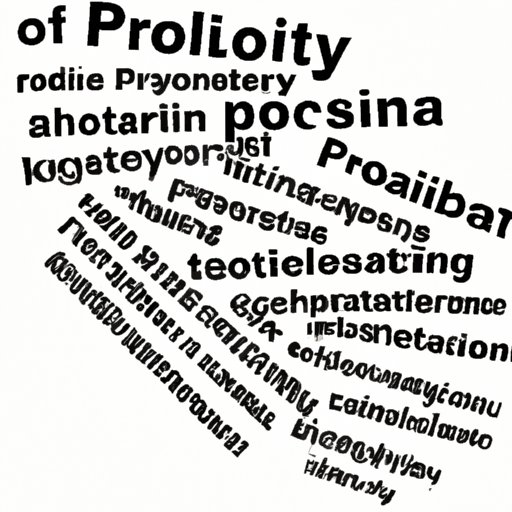Introduction
Postmodern literature is a type of writing that emerged in the late twentieth century as a reaction against modernist literature. It is characterized by an emphasis on fragmentation, irony, intertextuality, and a playful approach to language. Postmodern literature also often draws on popular culture for inspiration and challenges the notion of absolute truth. In this article, we will explore the various characteristics of postmodern literature in more detail.
Explores the Fragmentation of Identity
One of the main themes explored by postmodern literature is the fragmentation of identity. This can be seen in works such as Margaret Atwood’s The Handmaid’s Tale, which examines how individuals struggle to maintain their sense of self in a repressive society. Similarly, Toni Morrison’s Beloved looks at how the legacy of slavery affects the identity of characters in the novel. As scholar Susan Stanford Friedman has noted, “The fragmented, multiple, hybridized identities that characterize postmodern subjectivity are particularly evident in postmodern women’s writing.”
Rejects Traditional Narrative Structure
Another characteristic of postmodern literature is its rejection of traditional narrative structures, such as linearity and causality. Instead, postmodern works often feature non-linear storylines, non-traditional characters, and unconventional plot developments. One example of this is Thomas Pynchon’s Gravity’s Rainbow, which follows a wide variety of characters through a complex web of events. As scholar Linda Hutcheon notes, “Pynchon’s narrative structure is a radical departure from the traditional…It’s a work that deliberately rejects the conventions of narrative closure.”
Embraces Irony and Parody
Postmodern literature also often uses irony and parody to make its points. For example, Don DeLillo’s White Noise is full of ironic observations about consumer culture and media saturation. Similarly, Kurt Vonnegut’s Slaughterhouse-Five uses absurdist humour to critique the horrors of war. As scholar Linda Hutcheon explains, “Postmodern texts tend to use irony and parody as devices to undermine the validity of conventional values, beliefs, and attitudes.”

Uses Intertextuality to Create Meaning
Postmodern literature also often makes use of intertextuality, which is the practice of drawing on other texts to create meaning. For example, Salman Rushdie’s Midnight’s Children contains numerous references to Indian mythology and literature. Similarly, David Foster Wallace’s Infinite Jest draws on a wide range of sources, from classical literature to pop culture. As scholar John Frow notes, “Intertextuality is one of the central aesthetic practices of postmodernism.”

Draws on Popular Culture for Inspiration
Postmodern literature also often draws on popular culture for inspiration. For example, Mark Z. Danielewski’s House of Leaves features references to films, television shows, and video games. Similarly, William Gibson’s Neuromancer incorporates elements of sci-fi and cyberpunk. As scholar David Harvey notes, “Postmodernism…draws heavily for its imagery, symbols and metaphors from the world of popular culture.”
Focuses on Language as a Tool of Power
Postmodern literature also often examines the role of language as a tool of power. For example, Michel Foucault’s Discipline and Punish looks at how language is used to control and manipulate people. Similarly, Jean Baudrillard’s Simulacra and Simulation examines how language shapes our understanding of reality. As scholar Steven Best notes, “Postmodernists view language not just as a means of communication but as a form of power.”

Challenges the Notion of Absolute Truth
Finally, postmodern literature often challenges the notion of absolute truth. For example, Jorge Luis Borges’s stories often feature characters who are unable to distinguish between reality and fantasy. Similarly, Umberto Eco’s The Name of the Rose examines how different interpretations of religious texts can lead to radically different conclusions. As scholar Richard Rorty notes, “Postmodernism…emphasizes the impossibility of finding a single, final, objective truth.”
Conclusion
In conclusion, postmodern literature is characterized by a number of distinct features, including fragmentation of identity, rejection of traditional narrative structures, embrace of irony and parody, use of intertextuality, focus on popular culture, and challenge of the notion of absolute truth. These characteristics make postmodern literature an interesting and unique genre that continues to inspire readers and writers alike.
For those interested in exploring postmodern literature further, there are many excellent resources available. Scholars such as Linda Hutcheon, David Harvey, and Steven Best have written extensively on the topic, and there is also a wealth of postmodern literature available for readers to enjoy.
(Note: Is this article not meeting your expectations? Do you have knowledge or insights to share? Unlock new opportunities and expand your reach by joining our authors team. Click Registration to join us and share your expertise with our readers.)
